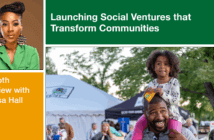In January, Doug Powe and Ann Michel of the Lewis Center identified eight notable trends in 2020’s swirl of change. Some trends have been underway for some time, but accelerated significantly in 2020, for example the church’s embrace of online ministry. But in other areas, the events of 2020 have led to renewed emphasis on the basics — prayer, fellowship, faith formation, and the call to racial justice. justice.
En español — 8 tendencias que afectan el liderazgo de la iglesia el 2021
For the past several years, at the start of the new year we have identified major trends and changes we see shaping the contours of congregational life. The year 2021 dawns at a time when the COVID-19 crisis has brought more change to our churches in a few months than most of us have witnessed in our lifetimes, and there is a growing sense that things will never return to where they once were. We remain in a very liminal period when we see only through a glass dimly. For that reason, we offer our observations this year cautiously but also hopefully, knowing that disruptive change brings great risk but also engenders creative and resilient responses.
An acceleration of underlying trends
While the events of 2020 are themselves unprecedented, many of the ensuing changes are not entirely novel. Crisis has a way of laying bare realities we may not see as clearly in “normal” times. Several trends that we have been monitoring for some time, which may have seemed far off on the horizon to the average church, are now front and center as a consequence of the coronavirus.
1. The importance of ministry in the digital realm
This time last year, we identified “the move to the internet” as the top trend for 2020. But we could not possibly have imagined how quickly congregations would embrace online worship, digital meeting spaces, electronic giving, and social media connections in the face of the pandemic. Many congregations report that their worship attendance and participation in meetings and groups have grown during this period as has their ability to connect with people from outside their immediate area. Some churches regard this foray into digital spaces as a temporary stopgap, and they expect to revert to their normal pattern of ministry as soon as possible. But forward-looking churches are capitalizing on this opportunity to hone their skills in digital outreach and develop a permanent online presence, not just to reach new people but to retain existing members who find they prefer the convenience of online engagement.
2. Changing staff configurations
In past years we have noted ongoing changes in the religious workforce including changes in how churches deploy their staffs. This trend gained momentum in 2020 as work-from-home orders and a pared-down schedule of events upended the day-to-day work of most church offices. The pandemic has forced some churches to downsize their staffs for financial reasons. And it has put a premium on a set of electronic communications skills increasingly vital to virtually every aspect of the practice of ministry. Some congregations are starting to think about hybrid or digital ministry positions. This may mean hiring someone who has technical knowledge but must be helped toward a better theological grounding.
3. The impact of church size
Large membership churches have long had an outsized influence on church life in America. However, many small congregations are quite stable and healthy, particularly if not overburdened by building expenses or compensation costs. We see this same pattern in the response to the pandemic. Larger, well-resourced congregations were far better positioned to transition to online ministry in the early days of the pandemic, and their technology and staffing advantages may make them even more dominant as online ministry takes root. But the pandemic also revealed the unique strength of many smaller churches who have sustained connections more easily during the shutdown due to their strong relational networks.
4. The waning role of denominations
The events of 2020 have also accelerated a decline in the influence and role of denominations that has been ongoing for several decades. In the face of continued membership declines and the financial impact of the pandemic, many mainline churches are struggling to support programs and administrative structures at the denominational level. There have already been layoffs, and more layoffs are likely in the future. Fewer and fewer individuals in the community are drawn to the denominational label of a church. Instead, they focus on the impact of the local congregation regardless of its affiliation. Going forward, we expect a continued diminution in the role denominations play in shaping the religious landscape.
Back to basics
Another theme we see in how churches have ministered in the face of the pandemic is a return to the basics. While born of necessity, this back-to-basics approach may be conducive to revitalizing faith formation at a time when older models, such as Sunday school, are losing currency.
5. Reevaluation of programmatic offerings
With many routine events and activities on hold, many churches are reassessing their programs and asking what needs to continue, what should be discontinued, and what needs to be done differently. Whether by design or default, most churches are in a shakedown period and will likely emerge with a slimmer ministry footprint that is more reliant on hybrid offerings that combine in-person and online engagement.
6. Renewed emphasis on prayer, pastoral care, and interpersonal connections
Shutdowns and stay-at-home orders have highlighted the importance of relational bonds within faith communities. With so many other activities on pause, many church members have rediscovered the foundational value of group fellowship and prayer, even if it happens via telephone or Zoom. For pastors and other leaders, it has required a far more creative and intentional approach to basic pastoral care.
7. Rediscovering home faith practices
In 2020, our homes became our sanctuaries, and parents took on the role of Sunday school teachers. This renewed attention to how we practice faith at home has revealed that many of us, particularly in mainline Protestant traditions, are a bit “out of practice” in this regard. For congregations seeking more effective approaches to faith development, particularly for children and youth, 2020 may have revealed one of the missing puzzle pieces — the need to equip people for meaningful personal devotions and help them foster faith within their homes and families.
8. Reclaiming leadership on racial justice
The experiences of 2020 also brought renewed attention to questions of racial justice, particularly following the death of George Floyd. Some churches have taken the opportunity to reexamine racial equity through the new lenses of anti-racism and Black Lives Matter. However, the church for the most part continues to be divided racially even as the nation grows closer with each successive generation to a time when the nonwhite population is no longer a minority. The church has an opportunity to provide prophetic, relevant leadership on what is perhaps the most pressing public issue of our day. Will we claim this calling? Or forfeit the opportunity to provide much-needed moral leadership?
Expect even more change
Within our churches, as in our communities, there is a palpable longing for a return to normalcy. But it is unlikely that 2020’s rollercoaster ride will come full circle and let us off where we got on. Our eyes have been opened to new possibilities, new patterns of relationship, and new ways of being together. Many of these changes are hopeful. But looking to the experience of other sectors that have migrated online (news and journalism, for example), new patterns of engagement and new approaches to economic sustainability are likely to emerge as the church ventures further into the digital sphere. The most important trendline we see as we look toward 2021 and beyond is that change is likely to beget even more change.
Related Resources
- Changes Congregations Face Leadership Study
- 5 Emerging Trends Impacting Church Life by Doug Powe and Ann A. Michel
- 9 Top Trends Impacting Church Leadership by Doug Powe and Ann A. Michel







